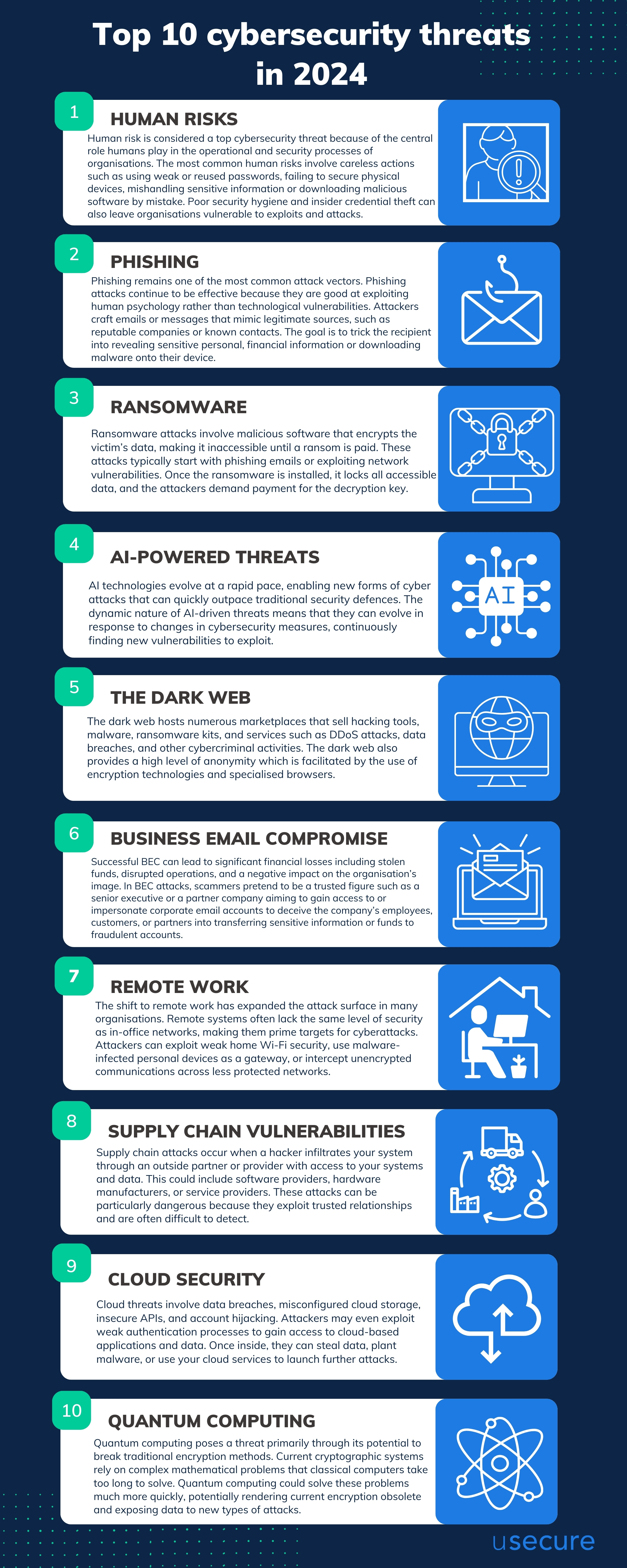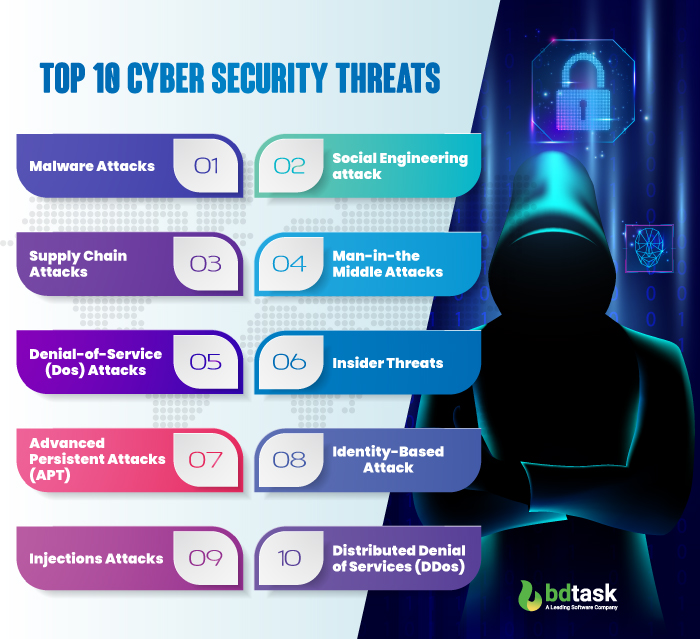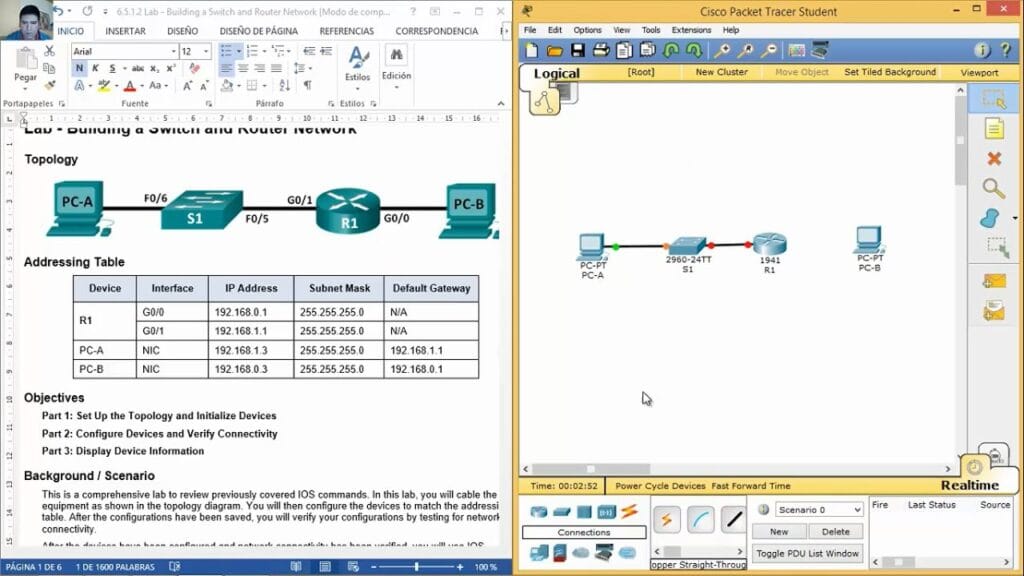Security threats are a growing concern worldwide. Understanding them is crucial for safety.
In our digital age, threats come in various forms. They target individuals, businesses, and governments alike. The complexity and frequency of attacks increase every year. From cyber crimes to physical breaches, security challenges evolve. Knowing the types of threats helps in preparing defenses.
It empowers us to safeguard sensitive data and protect assets. In this blog, we explore 10 common security threats. We aim to provide clarity on each threat’s nature. You will gain insights into how they operate and their impact. Our goal is to equip you with knowledge to enhance your security measures. Stay informed and proactive in protecting against these dangers.

Credit: blog.usecure.io
Phishing Attacks
Phishing attacks trick users into revealing sensitive information by pretending to be trustworthy entities. These cyber threats target email, social media, and messaging platforms, exploiting human vulnerabilities. Protecting personal data from such deceitful tactics is crucial in today’s digital age.
Phishing attacks are among the most common and dangerous threats in the digital world. They exploit human psychology, tricking people into revealing sensitive information. Imagine receiving an email that looks exactly like your bank’s official communication. You might not think twice before clicking on it. Such deceptions can lead to significant financial and personal losses.Email Scams
Email scams are a classic form of phishing attack. Scammers use emails to pose as trusted entities, often mimicking banks, retailers, or even friends. You might receive an urgent message about a security breach in your account, urging you to click a link and verify your details.Have you ever been tempted to respond quickly to such emails?That’s exactly what scammers rely on—your sense of urgency. Always inspect the sender’s address and look for signs of a fake. For example, your bank will never ask for your password via email.Deceptive Websites
Deceptive websites are another sneaky method used in phishing attacks. These sites look almost identical to legitimate ones, tricking you into entering personal information. You might land on a site through a link in a fake email or advertisement.Have you ever checked the URL closely before entering sensitive data?A subtle change in the web address can be a red flag. Legitimate sites often use HTTPS and have recognizable domain names. Always ensure you’re on the right site before entering any personal information.Phishing attacks prey on your trust and familiarity. By staying vigilant and verifying every communication, you protect yourself from these deceptive threats.Malware Infections
Malware infections are dangerous threats in the digital world. They can harm devices and steal information. Malware comes in many forms, each with its unique risks. Understanding these threats helps in protecting your data.
Viruses And Worms
Viruses and worms are common types of malware. Both can spread quickly and cause damage. A virus attaches itself to a file or program. It activates when you open the infected file. This can lead to data loss or system failure.
Worms, on the other hand, work differently. They spread across networks without user action. Worms can consume bandwidth and slow down systems. They can also deliver other harmful malware to your device.
Ransomware
Ransomware is another serious threat. It encrypts your files and demands payment. Until you pay, you can’t access your data. This type of malware often targets businesses. It can cause significant financial loss and damage to reputation.
Ransomware spreads through email attachments or malicious websites. Being cautious online can help you avoid these attacks. Regularly updating your software also reduces risks.
Denial Of Service
Denial of Service (DoS) attacks are a major security threat. They aim to make a network or service unavailable. Attackers flood the system with excessive requests. This overwhelms the infrastructure. Legitimate users are unable to access services. DoS attacks can disrupt businesses, causing loss of revenue. Understanding these attacks is crucial for protection.
Network Overload
Network overload is a common DoS attack method. Attackers send a massive amount of traffic to the network. This traffic saturates the bandwidth. The network becomes slow and unresponsive. Genuine users face connectivity issues. Businesses may experience downtime. Monitoring network traffic can help prevent overload. Implementing rate limits can reduce the risk.
Service Disruption
Service disruption is another impact of DoS attacks. Essential services become inaccessible. Users cannot perform critical tasks. Productivity drops, affecting business operations. Attackers may target specific services. This includes websites, applications, or databases. Regular backups and redundancy can mitigate disruption. Quick recovery plans ensure services resume swiftly.

Credit: www.bdtask.com
Insider Threats
Insider threats are a growing concern in cybersecurity. These threats come from individuals within an organization. Employees or contractors can misuse their access. Their actions can harm the organization. Insider threats are often hard to detect. They can be intentional or accidental. Understanding these threats is crucial for security.
Employee Negligence
Employee negligence is a common insider threat. Mistakes happen due to carelessness. They can lead to data breaches. Employees may ignore security protocols. This increases risk. Sharing passwords or leaving devices unlocked can cause issues. Training employees can reduce negligence. Awareness programs are essential.
Malicious Intent
Some insiders act with malicious intent. They deliberately harm the organization. Their actions can be for personal gain. Revenge or espionage are motives. Malicious insiders may steal data. They might sell it to competitors. Detecting malicious actions is challenging. Monitoring and security checks can help. Organizations must stay vigilant.
Man-in-the-middle
Man-in-the-Middle (MitM) attacks pose serious security threats. Attackers secretly intercept and relay messages between two parties. This breach can lead to sensitive data exposure and unauthorized access. Understanding the mechanics of these attacks is crucial for protection.
Data Interception
Data interception involves eavesdropping on communication. Attackers capture data traveling between users and services. They can then access personal information like passwords and credit card details. This interception often goes unnoticed, making it very dangerous. Encrypting communications is a key defense strategy. Secure protocols like HTTPS help protect against these threats.
Session Hijacking
Session hijacking is another form of MitM attack. Here, attackers take control of a user’s session. They exploit vulnerabilities in web sessions to gain unauthorized access. Once inside, they can manipulate user accounts. This poses a risk to personal and business data. Implementing strong session management practices is essential. Regularly updating software and using secure connections can mitigate risks.
Sql Injection
SQL Injection poses a serious threat, allowing attackers to exploit database vulnerabilities. Hackers can access sensitive data, bypass authentication, and compromise systems. Understanding this threat is crucial for protecting digital assets.
SQL Injection is a sneaky trick used by hackers to mess with databases. It’s like when someone figures out the secret code to your diary and starts writing their own entries. This threat happens when attackers input harmful SQL statements into a form or URL to gain access to your data. If you’re running a website with a database, it’s crucial to know how SQL Injection works and how to protect yourself.Database Manipulation
SQL Injection can manipulate your database by changing data, deleting entries, or even adding fake records. Imagine logging into your favorite online store, only to find out that your order history is completely messed up. This can happen if attackers use SQL Injection to alter the information stored in your database.To prevent this, always validate user inputs and use prepared statements. This way, your database won’t execute harmful SQL commands. Have you ever thought about what would happen if someone could change your personal data? Taking steps to protect your database is essential.Unauthorized Access
With SQL Injection, attackers can gain unauthorized access to sensitive information. They can retrieve data such as usernames, passwords, and credit card details. Picture someone walking into your house without your permission and going through your belongings. That’s exactly how it feels when your database is breached.To safeguard against this threat, implement strong authentication methods and encrypt sensitive data. Regularly update your systems and conduct security audits. How secure is your website right now? Taking action today can prevent a major headache tomorrow.SQL Injection is a serious threat that can wreak havoc on your data. By understanding how it works and taking preventive measures, you can protect your website and its users. Are you ready to secure your database from these hidden attacks?Password Attacks
Password attacks are a common threat in the digital world. They target user credentials to gain unauthorized access. Strong, unique passwords are essential to protect against these threats. Attackers often use automated methods to guess or steal passwords. Understanding these attacks helps in strengthening defenses.
Brute Force
Brute force attacks involve trying many passwords quickly. Attackers use software to test all possible combinations. They aim to find the correct password by sheer volume. This method is simple but can be effective if passwords are weak. Longer, complex passwords make brute force attacks difficult. Using a mix of characters increases security.
Credential Stuffing
Credential stuffing uses stolen login details from past breaches. Attackers test these credentials on different websites. Many people reuse passwords across sites. This makes credential stuffing successful. Protect yourself by using unique passwords for each account. Enabling two-factor authentication adds an extra security layer. It helps prevent unauthorized access.

Credit: www.sprintzeal.com
Zero-day Exploits
Zero-day exploits are a significant security threat in today’s digital world. They occur when hackers exploit vulnerabilities unknown to software developers. These threats can cause severe damage before anyone even knows they exist. Businesses and individuals must understand and manage these threats effectively.
Unpatched Software
Unpatched software is a favorite target for zero-day exploits. Hackers find and attack weaknesses in software that developers have not fixed. This makes it crucial for users to keep their software updated. Regular updates often include security patches that protect against these threats.
Exploiting Vulnerabilities
Exploiting vulnerabilities involves taking advantage of flaws in software. Hackers use these flaws to gain unauthorized access or cause damage. This process can be quick and often goes undetected. Understanding these vulnerabilities helps in developing better defense strategies.
Social Engineering
Social Engineering is a crafty technique used by cybercriminals to trick individuals into revealing sensitive information or performing certain actions. Rather than exploiting technical vulnerabilities, these attackers prey on human psychology. You might think you’re too savvy for these tricks, but social engineers are skilled manipulators. They often use tactics that seem harmless or even friendly, making it easy for anyone to fall victim.
Pretexting
Pretexting involves creating a fabricated scenario to steal your personal information. Imagine receiving a call from someone claiming to be from your bank, verifying suspicious activity on your account. The caller might seem legitimate, using your name and banking details. But, the real aim is to extract more info or gain access to your account. Always question unexpected requests for your data, even if they seem plausible.
Ask yourself: Would your bank really call you to ask for sensitive information over the phone? Banks typically have secure methods for verifying your identity without needing detailed information. Trust your instincts, and if something feels off, take a moment to verify independently.
Baiting
Baiting involves enticing someone with an attractive offer or item to gain access to their information or systems. Picture finding a USB stick labeled “Confidential” in your office parking lot. Curiosity might tempt you to plug it into your computer. However, this is precisely what baiting relies on. That USB could be loaded with malicious software, ready to infect your system.
Wouldn’t you rather be safe than sorry? If you come across such a bait, hand it over to your IT department. They have the tools and expertise to handle such situations securely. Remember, if something looks too good to be true, it probably is. Your curiosity shouldn’t override your caution.
Social engineering attacks are all about exploiting trust and emotions. Stay informed, be skeptical, and always verify before you act. These simple steps can protect you from falling into the trap of social engineering.
Advanced Persistent Threats
Advanced Persistent Threats (APTs) are stealthy attacks on computer networks. They aim to steal sensitive data over an extended period. Unlike regular threats, APTs are sophisticated and difficult to detect. They use advanced techniques to infiltrate networks, often targeting specific organizations or industries.
Targeted Attacks
APTs often focus on particular targets. Hackers choose these targets for their valuable data. They customize their attacks to exploit specific weaknesses. This precision makes them highly effective.
These attacks may start with phishing emails. Hackers trick employees into clicking malicious links. Once inside, they move quietly, searching for valuable information. Their aim is not immediate damage but long-term data theft.
Long-term Infiltration
APTs can remain undetected for months or years. Hackers maintain a presence in the system, collecting data slowly. They use advanced methods to avoid detection. This stealth makes them hard to remove once inside.
During infiltration, hackers study the network. They learn how it operates and where data is stored. This knowledge helps them stay hidden while extracting information. Long-term infiltration poses a serious risk to security.
Frequently Asked Questions
What Are The 10 Most Common Types Of Cyber Attacks?
The 10 most common cyber attacks are phishing, malware, ransomware, denial-of-service, man-in-the-middle, SQL injection, zero-day exploit, cross-site scripting, brute force, and credential stuffing.
What Are The Main Types Of Security Threats?
Main types of security threats include malware, phishing, ransomware, insider threats, and denial-of-service attacks. Malware includes viruses, worms, and spyware. Phishing tricks users into revealing sensitive information. Ransomware encrypts data for ransom. Insider threats come from within an organization. Denial-of-service attacks overload systems, disrupting services.
Stay vigilant to protect assets.
What Are The 10 Forms Of Cyber Security?
1. Network security protects networks from unauthorized access. 2. Application security secures software applications. 3. Information security safeguards data integrity and privacy. 4. Operational security manages processes to protect data. 5. End-user education trains users on security best practices. 6.
Cloud security secures cloud data. 7. IoT security protects interconnected devices. 8. Mobile security secures mobile devices. 9. Identity management controls user access. 10. Disaster recovery plans restore systems post-incident.
What Are The 8 Main Cyber Security Threats?
The eight main cyber security threats include phishing, malware, ransomware, insider threats, DDoS attacks, SQL injection, zero-day exploits, and advanced persistent threats. Protecting against these requires vigilance and updated security measures.
Conclusion
Security threats come in many forms. Understanding them is crucial. Each threat poses unique challenges. They require different strategies to combat. Stay informed to protect your data. Regular updates help shield your systems. Train your team on security practices. Awareness is the first line of defense.
Use strong passwords and change them often. Monitor your networks for unusual activity. Adopt security measures that fit your needs. Safety should be a priority in your digital life. Your vigilance can prevent costly breaches. Always strive for a secure environment.
Protecting your assets starts with awareness.










